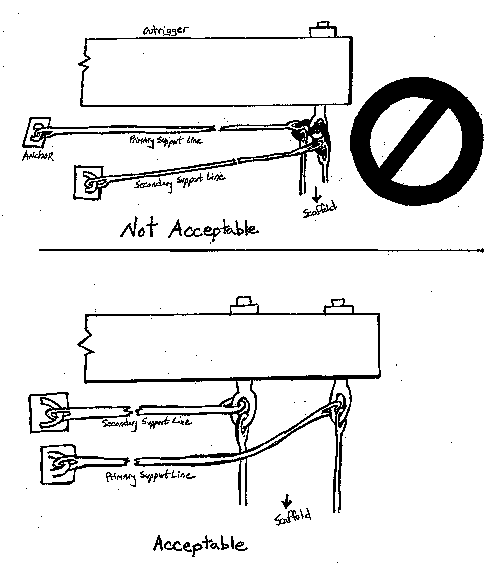- Standard Number:
OSHA requirements are set by statute, standards and regulations. Our interpretation letters explain these requirements and how they apply to particular circumstances, but they cannot create additional employer obligations. This letter constitutes OSHA's interpretation of the requirements discussed. Note that our enforcement guidance may be affected by changes to OSHA rules. Also, from time to time we update our guidance in response to new information. To keep apprised of such developments, you can consult OSHA's website at https://www.osha.gov.
June 16, 1999
Karl Guntheroth
Project Engineer
23307 66th Avenue South
Kent, Washington 98032
Re: 29 CFR 1926.451(g)(3)(iv)
This is in response to your letter dated July 22, 1998, in which you ask about OSHA requirements regarding multilevel suspended scaffolds. As you know, you originally sent your letter to our Region X office in Seattle, WA., and they forwarded the letter to us. In your letter, you ask questions that relate to the requirement in 29 CFR 1926.451 that lifelines, support lines and suspension ropes not be attached to a common anchor point.
Primary and secondary support lines may not be attached to an outrigger by a common shackle
First you ask if it is permissible to attach both the primary and the secondary support lines to a common shackle on one outrigger. In your example each line has separate tiebacks to separate anchor points on the building. In your view it should be permissible to use a common shackle to attach both lines to the outrigger as long as the support lines would remain attached to their tiebacks if the common shackle were to fail.
29 CFR 1926.451(g)(3)(iv) states that "vertical lifelines, independent support lines, and suspension ropes shall not be attached to each other, nor shall they be attached to or use the same point of anchorage, nor shall they be attached to the same point on the scaffold or personal fall arrest system." Since the outrigger is part of the scaffold, by connecting the primary and secondary lines to the outrigger with a common shackle you would be attaching those lines to a common point on the scaffold. It is, however, acceptable to attach both the primary support line and the secondary support line to the same outrigger as long as they are attached at different points. When using this arrangement, the secondary support line should be located at a point on the outrigger that will minimize the distance the scaffold will travel if the primary support line fails. (See attached drawing).
Use of hoists with built-in secondary ropes are permitted where secondary lines are not mandated
In your next question you ask if the use of "engineered and tested components such as hoists with built-in secondary rope brakes, stirrups and davits" would allow the attachment of both the primary and secondary support lines to the same point on the scaffold. When using a single level suspended scaffold, an engineered hoist that is manufactured to house both the primary and secondary support line may be used since a secondary support line is not required. However, employees working on the scaffold must still be protected with a personal fall arrest system.
If a multi-level suspended scaffold is used, then this type of manufactured hoist does not comply with OSHA regulations. Under §1926.452 (v)(1) these scaffolds are required to have additional, independent support lines. The type of hoist you describe attaches to the scaffold in such a way that both the primary and secondary support lines attach to a single point on the scaffold. Since these lines are ultimately attached to a common point on the scaffold, the lines are no longer independent and impermissibly attach to a common point. If the hoist were to become detached from the scaffold, the secondary line would detach along with the primary line.
If you require any further assistance, please do not hesitate to contact us again by writing to: USDOL-OSHA, DOC-Office of Construction Standards and Compliance Assistance, Room N3467, 200 Constitution Avenue, N.W., Washington, D.C. 20210
Sincerely,
Russell B. Swanson
Director
Directorate of Construction


